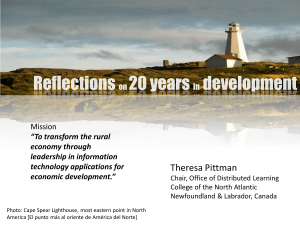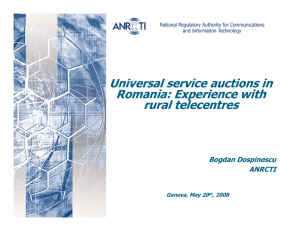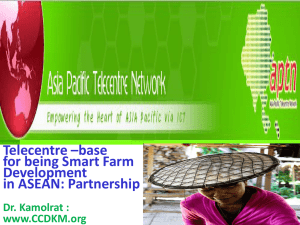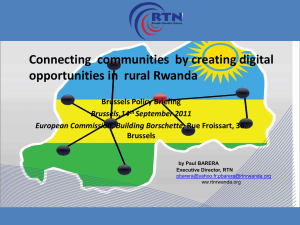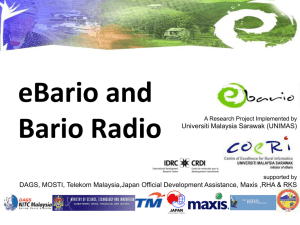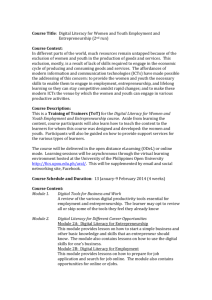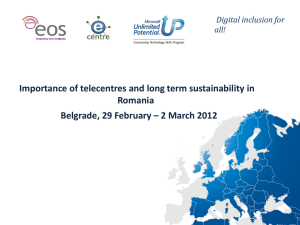INTERNATIONAL TELECOMMUNICATION UNION GLOBAL SYMPOSIUM FOR REGULATORS
advertisement
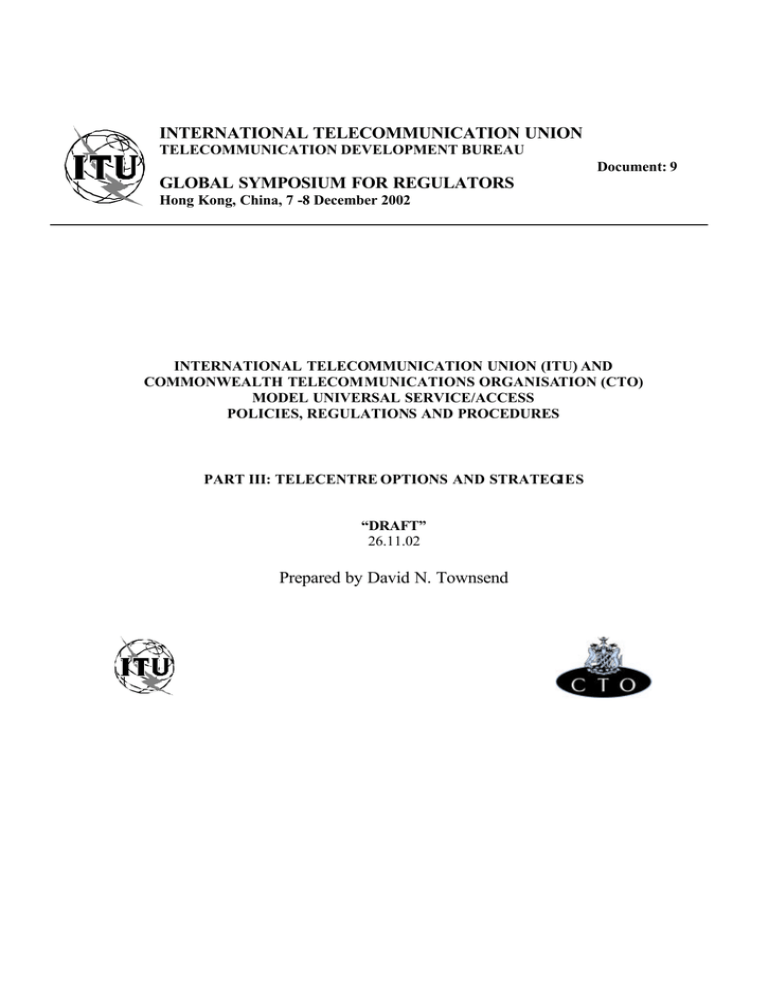
INTERNATIONAL TELECOMMUNICATION UNION TELECOMMUNICATION DEVELOPMENT BUREAU Document: 9 GLOBAL SYMPOSIUM FOR REGULATORS Hong Kong, China, 7 -8 December 2002 INTERNATIONAL TELECOMMUNICATION UNION (ITU) AND COMMONWEALTH TELECOMMUNICATIONS ORGANISATION (CTO) MODEL UNIVERSAL SERVICE/ACCESS POLICIES, REGULATIONS AND PROCEDURES PART III: TELECENTRE OPTIONS AND STRATEGIES “DRAFT” 26.11.02 Prepared by David N. Townsend Table of Contents I. INTRODUCTION ................................................................................................................... 2 II TELECENTRE DEFINITIONS AND MODELS................................................................. 3 2.1 Elements of a Telecentre: Supply and Demand........................................................................................................3 The Supply Side ............................................................................................................................................................................. 3 The Demand Side ........................................................................................................................................................................... 4 Telecentre Services........................................................................................................................................................................ 5 2.2 Telecentre Models .............................................................................................................................................................7 III. ECONOMIC ANALYSIS AND METHODOLOGY ....................................................... 9 3.1 Economics of Telecentres ................................................................................................................................................9 3.2 Supply Side: Costs of Telecentres ...............................................................................................................................11 Start-up Costs................................................................................................................................................................................ 11 Operating Costs ............................................................................................................................................................................ 11 3.3 Demand Side: Financing and Revenues ....................................................................................................................12 Start-up financing......................................................................................................................................................................... 12 Operating Revenues..................................................................................................................................................................... 13 3.4 Community and macroeconomic impacts ................................................................................................................16 Community impacts:.................................................................................................................................................................... 16 Macroeconomic impacts:............................................................................................................................................................ 16 IV. TELECENTRE IMPLEMENTATION PROCESSES .................................................. 17 V. POLICY AND REGULATORY ISSUES............................................................................ 19 5.1 Infrastructure ...................................................................................................................................................................19 Connectivity.................................................................................................................................................................................. 19 Quality............................................................................................................................................................................................ 20 5.2 Tariffs .................................................................................................................................................................................20 Telephone network connection services .................................................................................................................................. 21 End user telecentre services ....................................................................................................................................................... 21 5.3 Market liberalisation ......................................................................................................................................................21 ITU-CTO Draft Model Universal Service/Access Policies, Regulations and Procedures Part III I. Introduction This document is Part III of a three -part report (plus Annexes) that develops a recommended set of “model” policy provisions and methods for developing and least developed countries to promote expansion of access to information and communications technologies (ICTs), especia lly in low-income rural areas, and for historically disadvantaged populations. Part I of the report describes the model policy framework and recommended procedures for establishing and operating a Universal Service Fund (USF) as a central mechanism within a policy of marketoriented communications sector development. Part II addresses the processes for applying the Fund in soliciting competitive bids to construct subsidised new public access facilities in rural areas. This section Part III addresses the options for supporting Multipurpose Community Telecentres as a key resource for community access to basic and advanced ICTs. The concept of community-based telecentres has recently gained widespread attention as a strategically vital response to the perpetual lack of access to information and communications technologies and services in the developing world. While telecentres are not an entirely new idea, the strong emphasis on this new policy option offers an intriguing and encouraging approach to overcoming the wide disparities of access in the Information Age, and opportunities for enabling societies and historically disadvantaged regions and populations to participate in the newly emerging social and economic orders. Telecentres address two major concer ns with respect to telecommunications and information access: Ø First, while telecentres do not provide universal service to each household, they can offer universal access to basic telephone services--at a reasonable distance from the household--as a transitional options as universal service (i.e., teledensity) increases; Ø Second, telecentres can also provide a myriad of ICT services, such as access to the Internet, computers and software capabilities electronic commerce applications and to many other public information services. The telecentre models reviewed in this report offer numerous economic and social development opportunities for the communities they serve. While it is difficult at this time to quantify the exact impact of telecentres on the economic development of specific communities, it is clear that telecentres can have a vastly positive impact at the community level. For example, as a new small, medium and micro enterprise (SMME), a telecentre can not only provide access to basic telephones and ICTs, but can also facilitate other services, such as computer training classes or health education seminars. As a multi-purpose business, telecentres can help increase employment opportunities, cultural awareness, political participation, and overall empowerment of disadvantaged groups. This new trend focusing on telecentres as a tool for economic development, influenced by the rapid development of communication technologies, such as the Internet, has put the telecentre concept at the central stage of telecommunications policy and regulatory discussions worldwide. This report considers telecentres as a point of access to basic communications services, as well as to other ICT services, and the role that Universal Service Fund (USF) support can play in encouraging and promoting telecentre programs. 2 ITU-CTO Draft Model Universal Service/Access Policies, Regulations and Procedures Part III II Telecentre Definitions and Models In essence, telecentres are a means to increase access to telecommunications services as well as to the broader range of information and communication technologies (ICTs). Telecentres may differ in terms of size, services offered, technology used, and available infrastructure, as well as location, ownership, and relationship with other public facilities. It is precisely because of this flexibility that the concept of telecentres is so attractive as a tool for economic development, especially in rural communities. Instead of obeying to a rigid prescription, they can be shaped according to the requirements of specific communities, and based upon the available infrastructure. In addition, the concept of a telecentre will continue to evolve with technology, business opportunities, and the demand for services by the population being served. 2.1 Elements of a Telecentre: Supply and Demand We define telecentres based on a supply and demand model. That is, a telecentre depends upon both those technologies and services that it is capable of providing to the public, and the demand for applications that will meet the needs of the specific community or market it targets. The Supply Side The supply side of the telecentre refers to what telecentres can offer, in terms of both infrastructure and services. The telecentre infrastructure also reflects the technological capacity available, which is a main determinant of the types of services that can be offered. The key supply elements of telecentres include: § § § Hardware or physical infrastructure, including telecommunications access and backbone connectivity; electrical power; physical buildings; and technical equipment such as telephones, computers, and faxes; Software infrastructure, including available services and applications for users (interfaces, programs, as well as training materials), and also business management methods and materials for the telecentre managers; Human resource infrastructure, meaning the personnel who operate the telecentre, their degree of skills and resources, and the roles that they play in managing the telecentre, providing service to users, and contributing to training. The supply side of a telecentre is particularly important in budgeting considerations. For example, management systems and training plans are some of the most crucial components of a successful telecentre, yet they are often neglected in the planning of a telecentre budget. These items may be less capital intensive, but if they are not properly included in the financial plan, the chances of success for the telecentre operation will be compromised. In addition, supply side inputs and resources must be evaluated on an on-going basis to remain aligned with the demands of the telecentre market. 3 ITU-CTO Draft Model Universal Service/Access Policies, Regulations and Procedures Part III Where Universal Service Fund (USF) support is utilised as a foundation for launching individual telecentres or networks of telecentres, the decisions on allocation of funds and evaluation of operating mode ls must be consistent with overall USF objectives, as discussed in Part I of this model. This includes consideration of which elements of a telecentre’s infrastructure and service should be financed by the USF. This point is discussed further in Section 3. 2 below. The Demand Side The demand side is the primary driver of a telecentre project. For a telecentre to be successful, it must address the economic demand and social needs of the community and markets it serves. Economic Demand Vs. “Needs Analysis Telecentre projects reflect two important policy goals: on one hand they are a means to increase universal access to telecommunications services, and on the other they provide an economic development opportunity to the communities and population they serve. These are compatible but not identical objectives, and the characteristics of each should be examined. Viewing telecentres as a public service leads to the concept of "needs analysis": focusing upon the services that will bring basic communication capabilities to a community, to allow citizens to participate in national society, to have access to essential information, emergency services, and the ability to connect with family and colleagues around the country. These "needs" have been traditionally identified as a primary motivation for extending telecommunications networks to unserved areas, even if the service must be subsidised for persons who cannot pay the costs involved. The second perspective recognises a potential business case opportunity in telecentres, by focusing on the notion of "economic demand" for communication services (and related offerings). "Demand" differs somewhat from "need" in the sense that demand measures the willingness and ability of the user market to pay for the services that they desire. This willingness to pay may derive from a perceived need for an essential capability, or it may reflect new business or other money-earning opportunities enabled by the communications services. The differences between needs and demand are important for planning and management of the telecentre operations, and also for the USF’s policy priorities. The mandate of universal service policies, in the first instance, is to supply citizens' needs for information and communications services, and the money from the USF is intended to support this objective. At the same time, however, if telecentres can offer services that customers are willing to pay to receive, and thereby generate profits for their owners and economic development within the community, they will be much more viable and self-sustaining operations. The perspective of the telecentre as a business implies that the operator will not only respond to requests for service, but will actively investigate the market and promote its services to appeal to a broad user population. The process of defining the right mix of services and engaging potential customers will go a long way to determine the success of the telecentre. These will 4 ITU-CTO Draft Model Universal Service/Access Policies, Regulations and Procedures Part III certainly include access to basic telephone and information services, with subsidised prices for at least some users, to ensure that the fundamental universal service/access mandate is fulfilled. The challenge for telecentre operators will be to extend their business beyond this basic market, both to become profitable for themselves, and also to enhance the economic impact of telecentres throughout the community. There are two general types of services that can be provided by a telecentre: basic services and value added services. The extent of potential demand for these types of services is fundamental in determining what type of telecentre model to implement in different locations and conditions. Demand for services is therefore the primary driver for telecentre implementation and should be considered one of the most important variables in determining the feasibility of a telecentre project. Telecentre Services The following sections summarise the types of services that can be offered within each category: Basic Services In general, Basic Services are services that are delivered using a common network infrastructure and software platform, such as the basic backbone telephone network, and standard voice telephone instruments. Basic services focus primarily on the goals of increasing universal access to infor mation and communication technologies. These services meet the basic needs of the community, but are also likely to be a foundation for economic development. Basic services should be provided by the telecentre at specific, affordable prices and should contribute to the overall revenues of the business, but may not in all cases be profitable by themselves. Basic services generally consist of the following: 5 ITU-CTO Draft Model Universal Service/Access Policies, Regulations and Procedures Part III Box 1: Telecentre Basic Services • Telephone. Access to working telephones for out-going calls 24 hours a day. • Facsimile. Access to outgoing and incoming fax services, either selfservice or with assistance of an attendant. • Printing, Photocopying, Desktop Publishing. Access to various basic technical support services, either self-service or with assistance of an attendant. • Computer services. Access to computers for numerous needs, such as word processing, spreadsheets, business and personal planning, etc. • Electronic mail. Access to e-mail accounts provided by the telecentre or via the Internet; should include universal e-mail addresses. • Internet Access. Access to Internet connections using the telecentre computers and infrastructure; potentially subject to some access restrictions. • Voice Messaging. Access to voice mail service to guarantee access to incoming calls. Telecentre Value Added Services (TVAS) Telecentre value added services (TVAS) involve add-ons to the basic infrastructure and software platforms of the telecentre, and will typically require additional resources, both technical and human. TVAS add value by providing specific information, capabilities, and support to users, with the aim to stimulate other economic (and social) benefits outside of the realm of pure communication. Some value added services will be supported by government departments from other public budgets, such as education and health services, to further particular public service objectives. Even though this type of funding may be from the government, from the perspective of the telecentre it is still a form of "revenue", and both the government departments and the end user populations can be considered the "customers" of these telecentre services. Other value added services will be directly aimed at the private sector, to support business opportunities and economic development, such as training in computer skills, financial and business support services, and electronic commerce applications. 6 ITU-CTO Draft Model Universal Service/Access Policies, Regulations and Procedures Part III Following are examples of some of the most prominent types of TVAS, although different telecentre operators may seek to develop their own ideas: § § § § § § § 2.2 Tele-Health Tele-Medicine Local broadcasting Tele-Education Government programs and information Electronic Post Office Electronic Commerce Telecentre Models The key objective of the telecentre implementation process, both as an overall policy and as a central objective of USF support, is to establish telecentres as viable and sustainable commercial opportunities that also provide essential community services. Therefore, it is crucial to allow telecentre models to be flexible, so as to shape them according to the needs and demands of the community where they are located. The telecentre models recommended here consider various degrees of local development (e.g., infrastructure available, economic development), community requirements, and available resources, in different locations in a country. The strategy behind this telecentre implementation plan is one of applying different modalities of telecentre prototypes, applications and even services according to each situation. Consultation with government agencies and departments, with the private sector, and also with those with similar telecentre implementation experiences from around the world, has led us to the following categorisation of telecentre models or types. The table below provides a brief description of the proposed telecentre models. Tele -shop or Micro-telecentre. Tele-shop is a micro-business providing access to an individual phone for community use, comparable to a public payphone. The tele-shop is modelled after the successful micro-enterprise business model developed by the Grameen Bank in Bangladesh. (www.grameenphone.com) Mini-Telecentre. The mini-Telecentre is a one-person micro-business operation. The miniTelecentre consists of a console which contains several ICT accessories, including: • • • • One or two telephone lines and instruments (wireline or fixed wireless); one full service personal computer, plus dial- up Internet access; one 3-in-1 or 4-in-1 device for printing, faxing, photocopying and/or scanning; an operational system and software for several services. Standard Telecentre. A Standard Telecentre is a small business offering a variety of services in the community. A standard telecentre facility consists of the following: 7 ITU-CTO Draft Model Universal Service/Access Policies, Regulations and Procedures Part III • • • • • • • 4 to 6 telephone lines; 4 to six computers with software; one dedicated fax line; one dedicated Internet access line; an overhead projector; a large production printer/photocopier, in some cases colour; cash register machine. In general, this model will evolve into, and be replaced by, one of the MCT model options. Multi-purpose Community Telecentre. The Multipurpose Community Telecentre (MCT) is a medium to larger size business operation. An MCT is a full service telecentre facility that includes, at the very least: • • • all of the services of the standard telecentre; additional capacity (telephone lines, computers, human resources, physical space, etc.) to expand the scope of usage; and potential additional facilities for local broadcasting, tele-health, tele-education, electronic commerce, tele-government information systems, and other value added services. ICT Cooperatives. The notion of an ICT Cooperative is based upon the model of rural telephone cooperatives that exist in several developing countries. This is a developmental concept, which can be researched and evaluated by a given country as part of its overall telecentre implementation plan. The main characteristics to be explored should include: • • • some degree of community/customer ownership of the business; provision of advanced ICT services, such as those contemplated for MCTs; connection of local businesses, institutions, and eventually private homes to the network, as an extension of basic telecentre services toward a true universal service model. It is important to keep in mind that any telecentre model can evolve into another model or into a new model all together. This flexibility allows telecentre projects to be viewed as business cases that can develop with changing economic and technological conditions and community needs. As businesses, telecentres will respond to market trends, demand, and innovation. 8 ITU-CTO Draft Model Universal Service/Access Policies, Regulations and Procedures Part III III. Economic Analysis and Methodology Telecentres can and should be economically viable entities. This principle reflects the evolving economic conditions in the telecommunications field, which increasingly support the finding that even advanced services in rural and low income areas can be self-sustaining, as well as reinforcing of broader economic growth objectives. It is also consistent with the objectives described in Part I of this modelI, which promotes market-oriented policies, with USF subsidies ideally serving only in a transitional, start-up capacity. The need for analysis of the economics of telecentres is therefore twofold. First, an overview should be conducted of the ranges of costs and revenues that can be anticipated for the different categories of telecentres (i.e., as part of the development of an overall rollout plan for telecentres nationwide). Second, the process of examining telecentre economics in the aggregate supports the need for individual investors and operators, as well as the USF Administrator and other financing sources, to conduct in-depth studies of the specific economic conditions that will determine the appropriateness and viability of alternative telecentre options in different community settings. 3.1 Economics of Telecentres The following diagram illustrates the basic supply and demand side characteristics of telecentre economics. Its components are explained in the sections that follow. Note that both supply and demand elements in the diagram are divided into "National" and "Local" categories. National costs are essentially costs that are determined at the national level, beyond the influence of any individual telecentre operator. Local costs are likely to vary across different communities, depending upon local conditions, and are mostly within the control of the telecentre operator. National financing and revenues, as indicated in the diagram, are those that can typically be obtained at the national level, either from the government, from banks, or from donor agencies. Local revenue sources include community support as well as direct payments from customers for telecentre services. 9 ITU-CTO Draft Model Universal Service/Access Policies, Regulations and Procedures Part III Figure 1: Ec ono mi cs of Telecen tre s Sup ply ( Co st) De ma nd (Fina nc i ng + Re ve n ue) Star tup Co sts Startup Fi nan cin g National Equipment, facilities Software Telecom network connection National USF financing, other gov't Private donation Borrowing Local Administrative, legal Construction Training Local Owner's capital Community contribution Customer deposits Ope rati ng Co sts Operati ng Re ve nue s National Telecom services Supplies (Debt service) National Donations, borrowing Subsidy Government services Local Salaries Rent, utilities Maintenance Security Local Community support Revenues from Services 10 ITU-CTO Draft Model Universal Service/Access Policies, Regulations and Procedures Part III 3.2 Supply Side: Costs of Telecentres Supply side factors affecting telecentre performance are relatively easier to anticipate than demand side factors. Costs to obtain equipment and build facilities, as well as to operate each type of telecentre, while the y may vary from one location to another, can still be predicted with reasonable certainty upon market research. Ideally the USF Administrator should undertake such research on a general level when it is considering funding a telecentre program, while the entities seeking USF support and approval for telecentre projects should be required to prepare detailed cost estimates as part of their applications. These sections summarise the general components and cost levels required for the various telecentre models. Start-up Costs National. Most of the start-up costs of telecentres will originate from sources that are national in scope, beyond the control of the entrepreneur or investor who seeks to establish the business. The principle sources of these investment costs will be the facilities and equipment that will go into the telecentre, such as telephones, computers, facsimiles, and so forth, as well as much of the software that will be required to provide certain services. Local. Local start-up costs are likely to involve primarily labour and services required to establish the telecentre. These can include various legal and administrative costs associated with starting any new business. Also, where facility construction is required, these costs will usually be paid to local contractors and workers, except where these may be provided by a community partner or donor. Training costs may also be required to support the preparation of the telecentre owners and employees; these costs may involve local or national sources, potentially including training courses that could be funded under a national or regional USF sponsored programme. Operating Costs National. Operating costs are incurred on an ongoing basis, and are necessary to keep the business running. To some extent, these costs may be directly tied to actual use of the telecentre’s facilities. The most pertinent cost of this nature, and one of the largest ongoing operating costs, will be payments to telephone operators for the telecommunications services that connect the telecentre to the outside world. These charges will be set at the national level, either by the carriers themselves or by the national telecommunications regulatory authority. The actual amount of these charges will be a combination of per-line fees, which the telecentre must pay on a monthly basis for each connecting line regardless of how much the services are used, and usage fees, typically per-minute call charges, which will only be incurred when customers use the telecentre to make calls. Telephone charges will be required for basic voice telephone calls, as well as for Internet, e-mail, and other data services. Other nationally-based operating costs could include supplies of various kinds that might be centrally procured, either through a joint purchasing programme of all telecentres (possibly sponsored by the USF), or individually from other sources. An additional form of ongoing cost 11 ITU-CTO Draft Model Universal Service/Access Policies, Regulations and Procedures Part III could also be debt service, i.e., payments to banks or other lenders in support of the initial financing of telecentre start-up costs. Local. There are several types of operating expenses that are likely to be incurred at the local level. The most significant of these should be salaries for employees, especially for larger telecentres. For the smallest operations, salaries will be equivalent to profits, as the owner(s) are likely also to be the principal telecentre employees as well. But as operations expand, telecentres will have to add new employees to provide service to customers, as well as to perform administrative and technical functions. Other locally incurred operating expenses include all building-related costs, such as rent, utilities, maintenance, and security – the last category represents an important cost to prevent theft or vandalism, and ensure the confidence of both employees and customers. 3.3 Demand Side: Financing and Revenues Estimating demand is one of the most difficult tasks in business planing. When considering historically disadvantaged communities, the task is even more complex, since demand for ICT services will vary depending upon price, local economic conditions, as well as perceptions about the value of the services. Despite these difficulties, there are various sources of information and methods that can be used to estimate current and potential demand, and the likely levels of revenues that a telecentre can be expected to generate. Start-up financing National. Telecentre operators will need to obtain sufficient up-front capital to pay for the facilities, equipment, services, and labor required to launch the business, and probably to operate it for some period until it begins to generate self-supporting income. A large proportion, but not all, of start-up financing will come from national sources. The USF will likely be the initial option for most telecentres, especially in the early stages of a national programme. The amount of this support will be limited by the USF’s available budget, and the amount allocated to this type of service, as opposed to other initiatives (see Parts I and II of this report). Other sources of initial financing could come from other government funds, outside donor organisations, and commercial loans. A potential telecentre operator's ability to solicit these types of funds will depend partly upon its ability to present a coherent business plan and community support, factors which can be enhanced by a certification programme under the auspices of the USF. Local. Some amount of start-up financing may also come from local sources. In particular, the investors proposing to start the business should be prepared, in principle, to put some of their own money into the telecentre, although in many cases this may be a quite small amount. Telecentre owner-operators might be supported by other local investors, including businesses that may recognise the potential value of the telecentre to themselves and to overall community development. In this respect, the community itself might be a source of financing for a telecentre. Among smaller villages, for example, there may be local funds available for minor projects, which 12 ITU-CTO Draft Model Universal Service/Access Policies, Regulations and Procedures Part III could be solicited to support establishing a community telecentre. If the telecentre project is to be communally owned, this type of financing would be especially important. Finally, an important source of start-up capital can come from customer deposits. If prospective users are anxious for access to telephone and information services, they should be willing to make reasonable down payments on service accounts to help speed up the creation of the telece ntre. Business customers in particular, should be able to provide such deposits in advance. In community models where the telecentre operation will take the form of a cooperative, customer deposits will be akin to shareholder equity investments. Operating Revenues National. Some amount of operating funds may continue to be available from national sources. Renewable grants and government support might be available, for example, and some amount of continuing USF funding may be utilised in support of certain targeted programmes, such as training. For the most part, however, telecentre operators will need to recognise that the ongoing viability of their business must primarily depend upon locally generated revenue sources. Local. Again, there may be certain renewable sources of local funding, from the community and local businesses. But the bulk of the revenues that will be necessary to operate a successful (i.e., profitable) telecentre must come from direct customer payments for telecentre services. These include basic telephone calling, fax, Internet, e-mail, as well as computer, printing, and copying services, all of which will carry usage charges that should be commensurate with the cost to the operator of providing those services. Exactly how these prices will be set is an important policy issue, but on the whole telecentre service prices should be as cost-oriented as possible. This means that telephone calls and Internet usage, for example, should be priced in direct relation to the charges paid by the telecentre to telephone companies and Internet Service Providers, plus some mark-up to cover labor and overhead costs. Similarly, value added services, where provided, should be charged according to the cost of the underlying facilities involved, as well as any extra employees or other costs required to provide the service. If government subsidies are provided to support particular value added services (VAS), these should ideally be used first to ensure that the service in question is itself financially viable, and then to support the overall infrastructure cost of the telecentre that offers the services. Revenue estimates. Ultimately, the potential magnitude of operating revenues is the single most important variable in determining the ongoing viability of a telecentre as a business. In an environment where government or donor financing will be quite limited, each telecentre must be prepared to generate enough income from its day-to-day operations to fund its operating costs, and also to provide a reasonable enough salary/profit for the telecentre owners to want to continue to support the business. At the same time, to estimate the likely range of revenues that a telecentre will be able to earn, and that all such operations will generate on a national scale, is the most challenging analytical exercise involved in creating either a local business plan or a national rollout and 13 ITU-CTO Draft Model Universal Service/Access Policies, Regulations and Procedures Part III implementation strategy. There are numerous uncertainties surrounding the factors that will influence demand, price of services, and the economic impact of telecentres upon communities, and there is very little practical experience with these technologies and services. The USF Administrator can assist with this process by establishing a basic framework for analysing a range of demand and revenue scenarios for each type of telecentre, in representative community settings. This foundation can help establish the parameters for both individual business plans as well as the national rollout forecast. This framework should be based upon the following principles: • Total demand for services provided by a particular telecentre will be primarily a function of the total population in the community(ies) served by the telecentre. • For a given population, willingness to pay for telecommunications and information services will be a further function of income levels, of both individuals and businesses. • Realised demand for specific services will depend upon the prices for those services, as well as the value of (or "need" for) the services among the target customer population. • Successful telecentres should be able to reinforce service demand over time, by helping to increase user value, and ultimately income, throughout the community. With a better understanding of the community socio-economic environment, as well as potential market size, telecentre operation and financial plans can be based on realistic expectations and therefore more likely to result in successful business cases. The table on the following page provides an illustrative sample of an economic forecast for a standard telecentre. (The financial figures are expressed in South African Rand.) 14 ITU-CTO Draft Model Universal Service/Access Policies, Regulations and Procedures Part III Table 1: Standard-Telecentre Business Plan Scenario Year 0 Demand Assumptions (annual) Telephone usage minutes Fax pages Photocopying/printing pages Computer services hours E-mail minutes Internet Access minutes Voice Messaging messages Usage Minutes Growth Rate Cost Estimates Initial Start-up Costs Physical Infrastructure Total Start-Up Costs USA Subsidy Total Loan 72,000 6,000 6,000 1,800 27,000 600 3,000 Year 1 93,600 7,800 7,800 2,340 35,100 780 3,900 30.0% 160,000 160,000 35.0% 104,000 Year 2 Year 3 Year 4 Year 5 121,680 10,140 10,140 3,042 45,630 1,014 5,070 25.0% 158,184 13,182 13,182 3,955 59,319 1,318 6,591 20.0% 205,639 17,137 17,137 5,141 77,115 1,714 8,568 10.0% 267,331 22,278 22,278 6,683 100,249 2,228 11,139 10.0% - - - - - 31,357 31,357 31,357 31,357 31,357 Operating Costs Salaries (@ least minimum wage) & Administrative expenses 43,200 Telecommunications expenses 63,120 Supplies (in support of basic services) 8,000 Maintenance and Repair 4,350 Building and Utilities expenses 2,500 Security and other expenses 5,000 Total Operating Costs 126,170 47,520 75,972 8,000 4,350 2,500 5,000 143,342 52,272 93,998 8,000 4,350 2,500 5,000 166,120 57,499 116,311 8,000 4,350 2,500 5,000 193,661 63,249 143,936 8,000 4,350 2,500 5,000 227,035 69,574 178,140 8,000 4,350 2,500 5,000 267,564 Total Expenses 157,527 174,699 197,477 225,018 258,392 298,921 Revenue Estimates Revenues from Telecentre Basic Services Telephone Fax Photocopying Computer services E-mail Internet Access Voice Messaging Total revenues from Basic Services 43,200 9,000 6,000 9,000 27,000 600 1,800 96,600 56,160 11,700 7,800 11,700 35,100 780 2,340 125,580 71,183 15,210 10,140 15,210 45,630 1,014 2,966 161,353 90,224 19,773 13,182 19,773 59,319 1,318 3,759 207,349 114,359 25,705 17,137 25,705 77,115 1,714 4,765 266,499 144,950 33,416 22,278 33,416 100,249 2,228 6,040 342,577 Net income from basic services (60,927) (49,119) (36,124) (17,669) 8,106 43,656 3,000 500 1,000 500 500 5,500 3,500 600 1,000 600 600 6,300 3,500 600 1,200 600 600 6,500 4,000 750 1,200 750 750 7,450 4,000 750 1,500 750 750 7,750 4,000 800 1,500 800 1,000 8,100 274,249 15,856 1,321 350,677 51,756 4,313 On-going Capital Costs (Loan payments) On-going Capital costs Net Income from Value Added Services Government supported services E-Commerce Services Business support services Financial Services Training Courses Total Revenues from Value Added Services Combined Total Revenues Combined Net Income Combined Monthly Net Income 31,357 102,100 (55,427) (4,619) 131,880 (42,819) (3,568) 15 167,853 (29,624) (2,469) 214,799 (10,219) (852) ITU-CTO Draft Model Universal Service/Access Policies, Regulations and Procedures Part III 3.4 Community and macroeconomic impacts If a telecentre programme (and the activities of the USF in general) is successful in its broader objectives, economic conditions at both the national and community level will ideally improve as a direct consequence of the activities of the telecentres and their users. This could result in a variety of impacts on the business prospects of the telecentres themselves, and hence on the forecasts. Telecentre operators should be prepared to anticipate and respond to these trends in their medium and long term planning. Community impacts: Potential economic benefits within the community served by a telecentre can include increased employment and a variety of income opportunities from applications of telecommunications technologies, for example for electronic commerce. The impact of these types of trends upon telecentre operations would be primarily on the demand side, increasing users' demand for basic and value added services, and also their willingness to pay for them. Macroeconomic impacts: At the national level, there can be numerous benefits due to telecentres, particularly through coordination of business activities and other communications across distant communities that may have previously been isolated. These impacts may also affect the demand side of telecentre operations, to the extent national employment standards and incomes improve with the growing economy. In addition, there should be an "externality" effect of increasing connectivity across the country's populations, with medium and long term benefits that are difficult to forecast, but certain to be substantial. The stronger impact is likely to be on the supply side, however, due to economies of scale and scope in the operation of telecentres themselves, the shared experiences and marketing that can be facilitated by the combined efforts of telecentre operators, which the USF can facilitate through a coordinated national telecentre programme, and cost savings on supply of services and equipment that accompany broad market growth. Where these impacts occur, telecentre operators can anticipate lower equipment and operating costs over time than those estimated in our breakeven calculations. (Declining start-up costs should be factored into future budget estimates for telecentre subsidies.) 16 ITU-CTO Draft Model Universal Service/Access Policies, Regulations and Procedures Part III IV. Telecentre Implementation Processes So far, this report has reviewed the objectives and vision for the development of telecentres, and the economic factors that will influence their operation. This section now turns to the essential functions that a USF administrator or national regulatory authority must perform to help launch and sustain a telecentre programme. Because most telecentres will ultimately be planned, financed, and operated by private or community individuals and organisations, the government’s role cannot be one of directly establishing or sustaining telecentres. The government should be the facilitator by whose efforts the incentives and opportunities for private investment in telecentres should be maximised. The USF Administrator can approach the development of telecentres from two general perspectives: either it can seek to establish a national strategy for launching a series of new telecentres, following common standards and criteria with pre-determined budgets and timelines, or it can make funding available to the general public for telecentre start-ups, and review each application on a case-by-case basis. The choice between these approaches should depend upon how much funding may be available specifically for telecentre support, the other activities that the Fund is sponsoring, and the resources and priorities of the Fund’s officials. Some of the key activities that the USF Administrator can undertake to promote a coordinated national telecentre programme include the following: • Publicity and Outreach promoting the benefits, opportunities, financial options, and experience of telecentres, and the means by which interested citizens can participate in their development; • Business plan assistance and certification of qualified proposals to establish new telecentres that meet the USF’s guidelines and serve the objectives of universal service, lending the credibility and shared resources of the telecentre programme to the prospective telecentre operator; • Financial support for a portion of the start-up costs of certified telecentre proposals that will be located in areas designated as most in need of universal service subsidy funding; the USF can also assist operators to solicit other sources of start-up and operating funding; • Training and support services for all certified telecentre operators under USF-sponsored training programmes, to provide them with the maximum technical skills and business knowledge necessary to be successful; • Research and development in relation to market trends, economics, and technical considerations, as elements of the long term evolution of the telecentre strategy; • Monitoring and evaluation of the experience of different telecentre operations, and sharing of success stories, strategies, pitfalls, and ideas among the national (and international) community of telecentres. 17 ITU-CTO Draft Model Universal Service/Access Policies, Regulations and Procedures Part III In addition to these public agency responsibilities, those individuals or organisations that are interested inbecoming telecentre operators must take a number of steps to transform the goal into a working reality. Ultimately, they must formulate a working business plan to support the initial investment and ongoing operation of a viable telecentre. Box 2: Elements of a Telecentre Business Plan • • • • • • • • • • • • • • Statement of Purpose (or mission) Governance and Legal Structure Organisational structure: management and human resources structure (recruitment and training) Community Description, its role and participation in the telecentre project Type of telecentre model, including infrastructure and equipment needs A five-year strategic plan (can include such ideas as potential expansion, introduction of new services, new programmes, etc.) A summary of main findings from a community/market research study to assess needs and demand for services Software infrastructure needs Human Capital and Training requirements Products and services: list all products and services and targeted markets Budget and financial projections Marketing Strategy Networking strategy Evaluation and Monitoring Plan The type of financial forecast shown in the previous section should also be developed as part of this business plan. 18 ITU-CTO Draft Model Universal Service/Access Policies, Regulations and Procedures Part III V. Policy and Regulatory Issues The effective development of the telecentre strategy also crucially depends upon a strong coordination of different players at the levels of policy and regulation. These policies should support the economic viability of telecentres, while also helping to integrate the telecentre concept with the broader evolution of the national information and communications infrastructure. Part I of this report recommends that the USF Administrator be integrated with the national communications regulatory authority, a step which would help ensure appropriate regulatory attention to these concerns. 5.1 Infrastructure Connectivity Telecentres will serve little useful purpose without being connected with the national telecommunications network infrastructure. The fact is that the areas where information and communication technology (ICT) services are most lacking, and thus where telecentres can provide the most benefits, are locations where often there is little or no telecommunications infrastructure currently available. (Indeed, other types of physical infrastructure may also be lacking, including electric power, roads, water, and so forth, and these, too, need to be addressed in a coordinated manner.) Clearly, the policy maker and regulator’s policies concerning the deployment of backbone network and access facilities needs to address these gaps effectively, to ensure that all telecentres that might be established will be able to connect fully with the national network. For those cases where network infrastructure is not available to provide immediate access connections, some form of policy needs to be established to ensure that access can be obtained in the most affordable and timely manner possible. Such a policy, in general terms, could encompass any of the following options: • Direct cost-based funding of the infrastructure as part of the telecentre plan: Under this scenario, the cost of extending the network would be considered a component of the start-up cost of the telecentre, to be financed from the same sources as other equipment and facilities (the telephone operator might have to be reimbursed by the telecentre investor if funding is channeled through the telecentre). • Universal Service Obligations (USO): This scenario assumes that the national full service operator and the other carriers can be required, under their USO requirements, to build out their networks to areas where telecentres will be built at no cost to the telecentre itself. USOs may need to be modifie d accordingly. Alternatively, a process such as that described in Part II of this report could be established, utilising the USF, specifically to secure connectivity for telecentre locations through a competitive bidding process. • Government subsidy, and/or integration with other infrastructure projects: It may be possible in many instances to fund a large portion of telephone network expansion costs in connection 19 ITU-CTO Draft Model Universal Service/Access Policies, Regulations and Procedures Part III with other public infrastructure initiatives in rural areas (e.g., including coordination of such network expansion with rural transportation or electricity projects). Advanced planning is key in this regard. • Market incentive policies: Incentive-based policies may be used to encourage carriers to build infrastructure into many telecentre locations , with the incentives relating to future potential customers and revenues generated by telecentre activity. In a competitive market scenario (see below), carriers could be granted franchise rights to connect telecentres in given areas in exchange for their future traffic. Quality Even where basic network infrastructure access is either already or potentially available, the successful development of the telecentre plan depends upon the capacity or quality that infrastructure as much the simple presence of telephone wires in a community. Many of the value added services envisioned for all but the most simple telecentres (the Tele-shops) anticipate access to reasonable quality data transmission capability, especially including Internet access, as well as connectivity to government information networks, and the like. To provide these types of services at even their least complex levels requires connectivity via telecommunications facilities that can transmit data at acceptable speeds (e.g., at least 14.4 kbps, and preferably far higher), with reasonable reliability, maintenance, and technical support by the network operator. For full-service MCTs, these requirements are even greater, and form a critical aspect of the viability of their operations. Policy makers may need to authorize MCT operators to use alternative technologies such as very small aperture terminals (VSATs) or wireless local area networks (WLANs) to ensure adequate Internet bandwidth. VSATs could also be used for a international gateway services, enabling MCT operators to sell international voice services. In general, the same range of options exists to address this issue. Where no network access is in place, certainly the policy must promote not merely minimal "access," but sufficient network capacity, quality, and service support to meet both immediate and potential expansion needs of telecentres in the area. Where there is already some degree of existing network access in a location designated for a telecentre, there should be a process of collaboration among the telephone operators, the regulatory authority, and the prospective telecentre management, to ascertain the adequacy of the present network facilities to support the telecentre's short and long term service plans. 5.2 Tariffs Tariffs (prices) for telecommunications services are also a regulatory issue. Part II of this report presents a detailed discussion of tariff related issues as they affect new rural telephone service operators generally. This section addresses how these issues affect telecentres in particular. Specifically, there are two types of tariffs that may need to be examined: • tariffs charged by the dominant national full service operator or other telephone network operators for (wholesale) connection services provided to telecentres; and 20 ITU-CTO Draft Model Universal Service/Access Policies, Regulations and Procedures Part III • tariffs charged by the telecentres themselves for (retail) services provided to their customers. Telephone network connection services All telephone calls and other services such as data transmissions that are provided from a telecentre need to be connected to the national (and international) telecommunications network, and will typically incur charges from the carrier, usually the national full service operator or a cellular operator, that provides the connection. Ideally, preferential tariffs should be provided by all carriers to all certified telecentres, to support the goal of affordable and universal service, in keeping with broader national policy mandates as discussed in Part II. Tariff policies for telecentres should also not be adversely affected by the rebalancing of the national full service operator’s tariffs. The national regulator should undertake an analysis of the long run incremental costs (LRIC) of providing connectivity to telecentres in general, and should consider the minimum charges that can be economically sustained, either on a fully rebalanced basis, or through explicit cross-subsidies if necessary. 1 End user telecentre services Most of the services provided by telecentres will require users to pay some charge, and as discussed previously these charges need to provide telecentre operators with their main source of recurring revenues. However, telecentre service prices should not be set too high, which could discourage use of their services and limit universal access. One key policy question is who should be responsible for reviewing and regulating these telecentre tariffs, the national regulator and/or the telecentre operators themselves. Telecentre managers should be in the best position to know what prices their market can afford, and also what charges are needed to cover operating costs. On the other hand, leaving tariff setting entirely to telecentre operators could result in at least some cases of excessive or unfair pricing practices. The best course of action might be for the regulator to establish general rules and procedures for telecentres to set their prices, along with review policies for cases where operators may be found to impose inappropriate prices on their customers. 5.3 Market liberalisation Finally, the policies to be defined by the national policy maker concerning the liberalisation of the national telecommunications industry will have profound impacts on the longterm prospects for telecentre development. In a competitive market, in which new carriers may be licensed to provide all forms of telecommunications connectivity, access, applications, and technologies, there are likely to be a variety of new ideas and opportunities to integrate the telecentre concept with other market-based entrepreneurial initiatives. To the greatest extent 1 For a further discussion of LRIC, see Trends in Telecommunication Reform 2000-2001: Interconnection Regulation. 21 ITU-CTO Draft Model Universal Service/Access Policies, Regulations and Procedures Part III possible, the national policy maker should support the potential for experimentation and innovation in the market, once the dominant national full service operator’s basic service monopoly franchise is terminated. Some of the possible new market arrangements that could occur in a liberalised environment include: • Joint ventures between new licensed operators and telecentre owners to provide enhanced infrastructure and services; • A consortium of telecentre operators applying for a license to offer national and international telephone services, with the profits flowing back into the telecentre businesses; • New USOs for license applicants, including connection of telecentres to high capacity networks and services; • Joint ventures between telecentres, new telecom licensees, and other investors such as ecommerce entrepreneurs to offer full-service ICT access, content, and business venture options to rural communities; • Specialised start-up companies, such as public payphone providers, Internet Service Providers, VSAT operators, etc., establishing new telecentre models, with USF certification, based on open-market, profit -oriented incentives. These scenarios are merely ideas that could occur in the wake of an ope ning of the broader market for the provision of telecommunications in any given country. The national policy maker’s liberalisation policy could be structured to encourage the most beneficial of these kinds of activities, tapping the vast potential of the unserved and under-served markets to create the most appealing incentives for those with ingenuity and vision to bring both economic development and social equality to all citizens. 22
